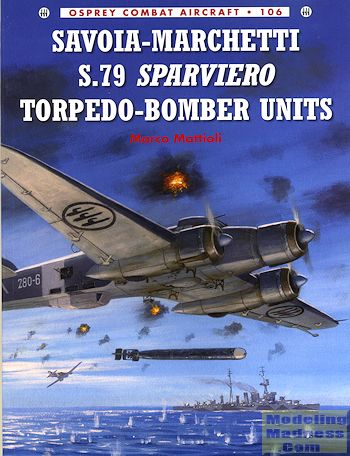 The
Italian air force was given a considerable amount of negative press during the
war and for decades afterwards. It is only somewhat recently that writers have
been able to sift through the propaganda left over from the war to look into
truth of history, stripping away decades of misinformation. What they have
uncovered is that the Reggia Aeronautica was not full of incompetent aircrew,
though some of its leadership was questionable.
The
Italian air force was given a considerable amount of negative press during the
war and for decades afterwards. It is only somewhat recently that writers have
been able to sift through the propaganda left over from the war to look into
truth of history, stripping away decades of misinformation. What they have
uncovered is that the Reggia Aeronautica was not full of incompetent aircrew,
though some of its leadership was questionable.
In fact, one branch was a considerable concern to the British and later the
Allies in the Mediterranean during WWII. That was the Italian torpedo bomber
squadrons. These were the most successful aerial torpedo units in the
European/Mediterranean side of the war. When WWII started, the Italians were
still building up their military and so did not have any torpedo carrying units.
It was soon decided that the tri-motor SM.79 would be the best plane to take on
this task. Though designed to carry two torpedoes, the additional weight and
drag of the second torpedo so degraded the performance of the aircraft that only
one was used during operations.
The Italians had the best torpedo in the theater and many consider it the
second best aerial torpedo of the war after that carried by the Japanese. So
successful was this weapon that it was used by the Germans for their torpedo
planes.
As is often the case, these units had their ups and downs. Initial operations
showed some flaws and once those were cured, these crews had a goodly amount of
success. As with every weapon, one doesn't get a hit every time and it seems
like the success rate in terms of hitting a ship was under 10% with even fewer
actually sinking. The early war would be considered the time of greatest success
with these units, especially since there were convoys headed towards Malta that
were well within the range of the torpedo units. Attacks on Port Said were also
successful as were the occasional forays to Gibralter.
As the war continued, the abilities of the torpedo units to get through the
ever increasing defenses decreased until finally it became nigh near impossible,
especially once the US got into the war in late 1942. After the Italian
Armistice in September 1943, some units operated with the Germans and others
with the Allies. Those with the Allies became transport units while those in the
ANR continued the role, but with very little success.
In this book, we look at the development of the
torpedo units as well as their many missions. This includes quite a few aircrew
stories as well as a more accurate look at their successes, something that the
hindsight of history can provide. While not as deadly as the Italians had
thought at the time, the SM.79
Included in the book are the usual great pilot stories, excellent period
photos, and a goodly number of full color profiles, covering all of the
intricate camouflage schemes carried by these aircraft. It makes for a great
read and is a mush have book for those who are truly into Italian WWII aviation.
November 2014
For more on the complete line of Osprey books,
visit http://ospreygrp.com
or contact them at Osprey Direct, PO Box 140, Wellingborough, Northants,
NN8 2FA, UK. In the US, it is
Osprey Direct at 44-02 23rd St, Suite 219, Long Island City, NY 11101., where you can
get a catalogue of available books.
If you would like your product reviewed fairly and
fairly quickly, please
contact the editor or see other details in the
Note to
Contributors.
 The
Italian air force was given a considerable amount of negative press during the
war and for decades afterwards. It is only somewhat recently that writers have
been able to sift through the propaganda left over from the war to look into
truth of history, stripping away decades of misinformation. What they have
uncovered is that the Reggia Aeronautica was not full of incompetent aircrew,
though some of its leadership was questionable.
The
Italian air force was given a considerable amount of negative press during the
war and for decades afterwards. It is only somewhat recently that writers have
been able to sift through the propaganda left over from the war to look into
truth of history, stripping away decades of misinformation. What they have
uncovered is that the Reggia Aeronautica was not full of incompetent aircrew,
though some of its leadership was questionable.